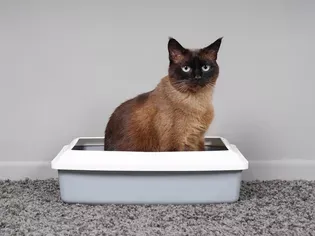How to Solve Common Litter Box Problems in Cats
Updated on 04/26/24

Mastering the Litter Box: Solving Common Feline Challenges
As devoted cat owners, we strive to provide our furry companions with the best possible care. A crucial aspect of that care is ensuring their litter box needs are met. However, even the most well-trained cats can occasionally encounter litter box mishaps. If your feline friend is suddenly expressing their discontent in the litter box, it's essential to address the issue promptly. This comprehensive guide will delve into the common causes of litter box problems in cats, providing practical solutions to restore harmony between you and your beloved pet.
Identifying the Root Cause: A Detective's Approach
The first step in resolving litter box problems is to pinpoint the underlying cause. Cats are meticulous creatures, and their elimination behavior can provide valuable clues about their well-being. By carefully observing your cat's litter box habits, you can narrow down the possible reasons for their reluctance or avoidance.
- Medical Conditions: Urinary tract infections, kidney disease, and digestive issues can all affect a cat's litter box behavior. If you observe any changes in their elimination habits, such as straining to urinate, frequent urination, or diarrhea, consult your veterinarian promptly.
- Litter Box Issues: Cats have specific preferences when it comes to their litter box. The size, shape, litter type, and location can all influence their willingness to use it. Ensure the litter box is spacious enough for your cat to comfortably turn around and dig, and avoid placing it in a high-traffic area or near potential hazards.
- Stress and Anxiety: Changes in routine, new pets or people in the household, and environmental stressors can trigger stress and anxiety in cats. When stressed, they may avoid the litter box altogether or exhibit inappropriate elimination behavior.
- Age-Related Changes: Senior cats may experience mobility issues or cognitive decline that can affect their litter box habits. They might struggle to access the litter box or forget where it is located.
- Inappropriate Eliminations: If your cat has suddenly started eliminating outside the litter box, it could be a sign of inappropriate elimination behavior. This can be caused by a variety of factors, including territorial marking, attention-seeking, or protests against environmental changes.
Tailored Solutions: Addressing Each Challenge
Once you have identified the underlying cause, you can implement tailored solutions to address the problem. Here are some specific strategies for common litter box issues:
- Medical Conditions: Seek professional veterinary care to diagnose and treat any underlying medical conditions that may be affecting your cat's litter box behavior.
- Litter Box Modifications: Experiment with different litter box sizes, shapes, and types to find what your cat prefers. Consider using a pheromone diffuser or calming spray near the litter box to create a more relaxing environment.
- Stress Management: Identify and address any sources of stress or anxiety in your cat's life. Provide plenty of hiding places, interactive toys, and interactive play sessions to help them stay calm and reduce anxiety-related elimination issues.
- Age-Related Considerations: Make adjustments to the litter box setup as your cat ages. Place the litter box in an easily accessible location and consider adding ramps or steps if necessary. Provide a non-slip surface around the litter box to prevent accidents.
- Inappropriate Eliminations: Rule out any underlying medical conditions that could be causing inappropriate elimination behavior. If a medical cause is not present, consult with a veterinarian or certified animal behaviorist to develop a behavior modification plan and address the underlying triggers.
Additional Tips for a Litter Box Haven
- Keep it Clean: Cats are naturally clean animals and prefer a clean litter box. Scoop out waste daily and change the litter completely once a week or more frequently as needed.
- Provide Multiple Boxes: For multi-cat households, provide one litter box per cat plus one extra. This ensures there are always clean options available.
- Location, Location, Location: Place litter boxes in quiet, private areas away from high-traffic zones. Avoid placing them near food and water bowls.
- Training and Patience: If you encounter any litter box issues, be patient and consistent with your training. Reward your cat for using the litter box appropriately, and avoid punishing them for accidents.
Conclusion: A Purr-fect Partnership
Understanding and resolving litter box problems in cats is crucial for maintaining a harmonious and healthy relationship with our beloved companions. By identifying the underlying cause and implementing tailored solutions, we can help our cats feel safe, comfortable, and confident in using their litter boxes. Remember, patience, consistency, and a loving approach are key to creating a purr-fect litter box experience for both you and your furry friend.
Explore More Pets

Cat Behavior Problems
How to Stop Aggression in Kittens

Long-Haired Cat Breeds
Siberian Cat: Breed Profile, Characteristics, & Care

Cat Behavior Problems
How to Stop Kittens From Scratching and Biting

Long-Haired Cat Breeds
Turkish Angora: Cat Breed Profile, Characteristics & Care

Basic Training
How to Socialize Your Kitten

Short-Haired Cat Breeds
Cute Pictures & Facts About Calico Cats & Kittens

Litter Box Training
Training Your Kitten to Use the Litter Box

Long-Haired Cat Breeds
10 Fun Facts About White Cats